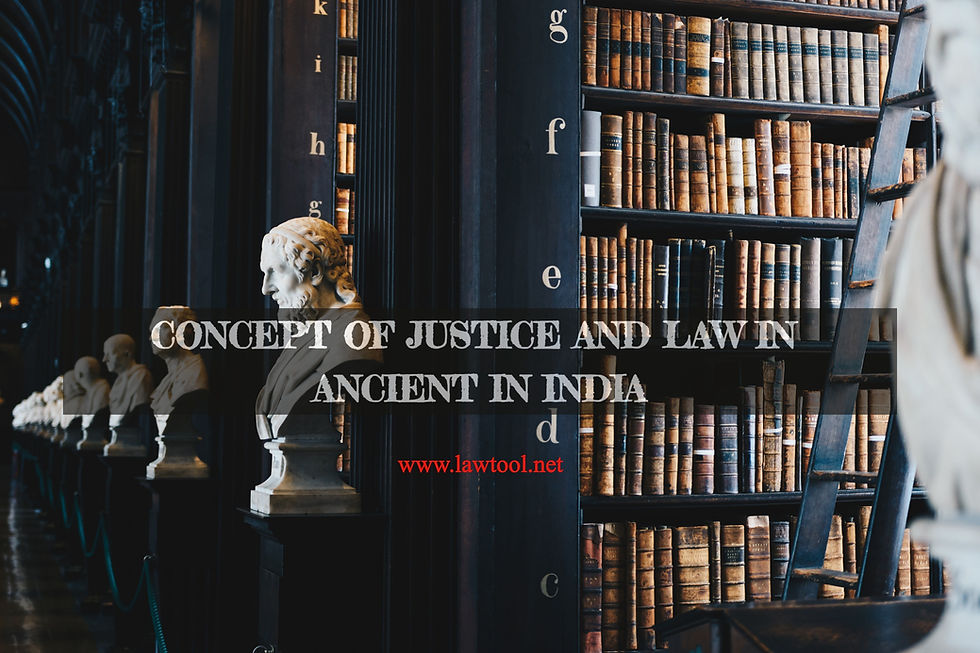CONCEPT OF JUSTICE AND LAW IN ANCIENT IN INDIA
- www.lawtool.net

- Oct 2, 2022
- 3 min read
CONCEPT OF JUSTICE AND LAW IN ANCIENT IN INDIA
The administration of justice was not a part of the duties of the state in the early times. We do not find mention of any judicial organization in the Vedic literature. The aggrieved party used to sit in front of the accused's house for redressal of his wrongdoing and would not allow him to walk till his (the aggrieved party)'s claims were satisfied or false. Later justice was administered by clan and clan assemblies and the judicial process was much simpler. But with the expansion of the functions of the state and the growth of royal powers, the king gradually came to be regarded as the core of justice and a more or less elaborate system of judicial administration came into existence. Dharma Shastra, Ethics and Arthashastra give us information about well-developed judiciary. According to this literature, the king is the source of all justice and he had to spend about two hours in adjudication every day. The supreme duty of the king is to protect his subjects which includes punishing the criminal. The law to be administered is theology subject to local and other uses not inconsistent with the scriptures.
TYPES OF COURTS
According to Brihaspati, there are four types of courts likes
Movable courts
Stationary courts
Courts deriving authority from the king and
Courts were presided by the king himself.
Brihaspati also mentioned three types of nomadic courts as following:
First: For the promote to forest dwellers.
Second: For the profit of caravan serai merchants.
Third: For the advantage of military men.
According to Bhrighu rishi: There were some of the prominent courts for justice are as follows:
The Kings Court: At the head of the judicial system stood the king's court at the capital and presided by the king himself. But more often a learned Brahmana was appointed for the purpose and he was known as Adhyaksha or Sabhapathi. Earlier the Adhyaksha was selected for each particular occasion and in course of time became a permanent officer of the state and held the position of the Chief Justice (Pradvivaka). Apart from the king, this court consisted of the Pradvivaka and three or four jurors.
Court presided by the Chief Justice: The court presided by the chief justice appointed by the king called Pradvivaka was the second type of court.
Principal Courts: Another court of importance were the principal courts in a large town where royal officers assisted by learned person administered justice. They were presided by Adhyakshas appointed by the central government.
Popular Courts: One special feature of the ancient Indian judicial system is the existence of popular courts.
According to Yajnavalkya for the first time refers to three types of popular courts.
Kula: The Kula has been defined by the Mitaksharaas consisting of a group of relations, near or distant. The Kula or joint families were often very extensive in ancient India. If there was a quarrel between two members the elders used to attempt to settle it. The Kula court was this informal body of family elders.
Sreni: When the effort at family arbitration failed, the matter was taken to Sreni court. The term Sreni was used to denote the courts of guilds which became a prominent feature of commercial life in ancient India from 500 B.C. Sreni had their own executive committees of four or five members and it is likely that they might have functioned as the Sreni court also for settling the disputes among their members. This was an assembly of persons following a particular profession like betel sellers, weavers, shoemakers, and such like.
Puga: Puga was an association of persons drawn from various castes and following different professions but staying in the same village or town. The Sabha or the village assembly of the Vedic period and the Gramavriddha court of the Arthasastra were the forerunners of the Puga court.










Comments